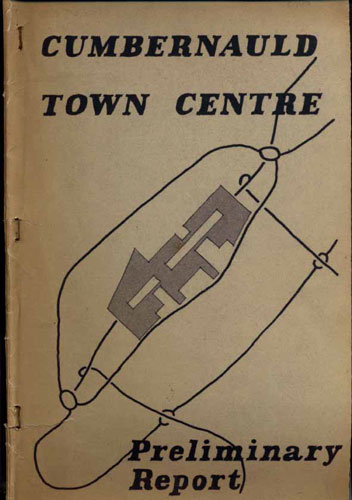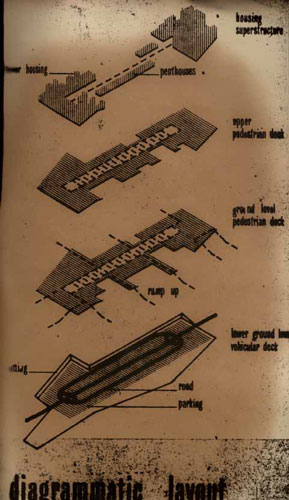

"One thing that’s forgotten is the tremendous pressure caused by the need to rehouse Glasgows’ population: in fact Glasgow became the only city in the world to attempt to solve its problems by depopulating itself. The Cumbernauld Development Corporation got a per-capita for every glasgow citizen they rehoused."
Derek Lyddon was planner for the South Side area: Carbrain, Kildrum. After Cumbernauld he went on to Skelmersdale New Town, and on to the Scottish Office.
You
don't like the
word Brutalism?
What might be termed brutalism was really trying to do the best with
the money available. We were very very short; the government said ”Your
doorhandles are far too expensive”, for example. "They’ve
all got to be plastic." There was a very strict area definition per
house. The Parker Morris report defined the
formula for size per person, and for the first time it defined minimum
standards, a space for the pram and so on . We worked between that
and the cost limits which
the government set. We did the best we could there, and then some outside
people came in and said ‘that’s brutalism’ because
you had flat roofs..there was scarcely any money available to do
anything else. So you could say brutal but you could
equally easily use the old fashioned phrase ‘functional’. As
simple as that.
Structure of the team?
Sir Hugh Wilson was appointed by the Scottish Office, then he selected further
recruitment and what he wasalways looking for was multi-professional teams.
A town centre
team, a Northside team under Roy Hunter, a Southside team which included me,
and
in each team there was architect, architect/planner, engineer, and landscape.
You
could always tell when the multi-teams were together because you could
go onsite and they’d all be criticising each other- about flooding on
the road or whatever- all interleaving in inquiry…. This was a positive
reinforcement. There were no pure planners- not until Urlan Wannop. Lives in
Helensburgh.
“
The impact of changed expectations” is a piece he wrote on the changes
to the projected population, and the economic factors of the late 60s and early
70s.
 |
 |
Hugh Wilson never
would have a master plan. He would have a preliminary report…
These images are from right at the beginning.
Hook New Town?
That’s one of my favourite stories actually…the Japanese came to
us and they said they were interested in Cumbernauld, had a trip, and
the tremendous model we had of the town. We asked if there was anything else
they wanted, and
they said, “we’d like to go and see Hook.” And Hugh
Wilson said.
“Oh. Well, you see, Hook is only a book.”
And they said, “Oh really? We’ve already built it.”
What about the CDC restauraunt, places that can't be reached any more?
The expansion
The original designated area was to house far fewer people than the government
wanted.
They wanted 60-70,000 and they only got 50, then they demanded a second
wave. This meant going off the hilltop, Hugh Wilson would never have
agreed to
that…
Was the centre not going to be off the hilltop originally?
Right at the very beginning there was a possibility that it could have
been down in the valley on the railway side, not the A80 side. That was
still
in the designated
area, then it was decided that if you wanted to have a centre
without
neighbourhood centres- all the previous new towns had
built to scale of neighbourhoods
based on the secondary school/2 primary schools/shopping centre- this
was the first
new town to say no to that. Partly because of topography, there wasn't
room to spread like that, partly to put a balance in. This was the first
new
town to
plan for
100% use
of the car, but 100% walking to the town centre.
Therefore it was placed in the centre and it so happened it was on
top of the hill as well.
Cultural influences
It was a new approach based on “ the whole town as the neighbourhood”
The centre in walking distance, based fairly uniquely on all the pedestrian
ways.
These footways complemented a road system that really did work well.
It was the right design for the site.
In the London new towns there was a time when they were getting a bad
reputation, people were depressed, commuting and so on. A feeling that
they wanted these
places to be a bit more dense and a bit more lively. “ You should be within
screaming distance of the next house”…and industrial areas close
to housing. It used to say on the marriage vows, ‘ for better , for worse,
but never for lunch.’..
The new towns were hit particularly hard by a certain kind of ‘inward
investment’- arrive, hoover up the grants, then off again…
Coming into the 60s the idea grew that the new towns weren’t just overspill
for the city, they were growth poles in the Central Belt. That was a very
big change in approach.
No longer relying on overspill to build population but bringing in new
factories and workplaces… this was picked up from the French.
High living:the penthouses
I remember Colin Cowan telling me that with the penthouses,when it came
to the right to buy, they had to scrap them as dwellings altogether,
because
it would
be so impractical to have private ownerships floating over the whole
thing. They reverted to offices didn’t they?
So it wasn’t tightened fire regulations?
Well that’s what colin cowan said to me…
Absorption
So now the whole centre is run by a shopping centre group, and
so you have a structure which was meant to be a civic centre in the widest
sense,
but
it’s
run like a mall…
I think there was a complete lack of understanding
on the part of the administration as to the potential of the place.
When the CDC folded, I think it went to the wrong local authority…
That may have been the tragedy- I think Cumbernauld looked much more
to Falkirk and north.
Hugh Wilson ran the office very much as a non-stratified team, and
after work we used to go to the pub in the village; very much a man
for teamwork.
There was a book written about 50 monuments postwar developments in
scotland. Seafar housing was labelled as one of the fifty developments… does
that ring a bell?